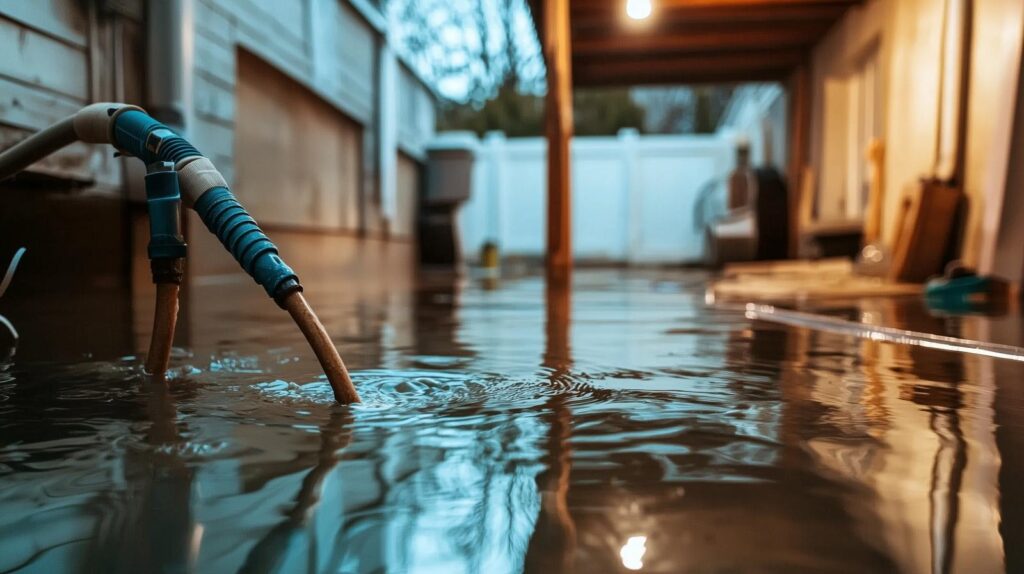
Contents
When faced with water damage, time is of the essence. You need to act quickly to minimize the impact on your property. Start by evaluating the situation without compromising your safety. It’s vital to identify the source and extent of the damage before taking further steps. But what’s the best way to guarantee a swift recovery? Let’s explore essential strategies that can help you tackle this challenge effectively.
Key Takeaways
- Conduct a thorough damage assessment to identify the source and extent of water intrusion quickly.
- Wear safety gear and check for electrical hazards before starting recovery efforts.
- Promptly remove standing water using wet/dry vacuums or submersible pumps for larger areas.
- Use dehumidifiers and fans to dry affected areas and maintain humidity levels between 30-50%.
- Inspect for mold in hidden areas and address any signs immediately to prevent growth.
Act Quickly to Minimize Damage
When water damage occurs, acting quickly can greatly reduce the extent of the destruction. The first step you should take is to conduct a thorough damage assessment. This helps you identify the source and extent of the water intrusion, enabling you to prioritize your response effectively.
Once you’ve assessed the damage, focus on water extraction. Removing standing water promptly can prevent further issues like mold growth and structural damage. Utilize pumps and wet vacuums to expedite the extraction process.
If the situation seems overwhelming, don’t hesitate to call in professionals who specialize in water damage recovery. They can provide the expertise needed to guarantee the extraction is done thoroughly and safely.
Ensure Safety First
Before you immerse yourself in the recovery process, ensuring your safety should be your top priority. Start by donning appropriate safety gear, including gloves and waterproof boots, to protect yourself from contaminants and sharp objects.
Check for electrical hazards; water and electricity are a dangerous combination. If you notice any exposed wiring or wet outlets, avoid contact and turn off the power at the main breaker if it’s safe to do so.
Make sure to assess the structural integrity of your space before entering. Look for signs of sagging ceilings or weakened floors, as these could pose additional risks.
Remove Standing Water Promptly
Once you’ve guaranteed a safe environment, it’s time to tackle the standing water. Quick action is essential, as stagnant water can lead to mold growth and further damage.
Start with water extraction; using a wet/dry vacuum can be effective for smaller areas. For larger spaces, consider equipment rental options like submersible pumps or commercial-grade water extractors. These tools can greatly speed up the process, ensuring you remove water efficiently.
If you’re unsure about handling this yourself, reaching out to professionals can provide peace of mind. They’ve the expertise and proper equipment to manage the water extraction effectively.
Don’t forget to wear protective gear during the removal process—your safety comes first. Once you’ve removed the standing water, you’ll be one step closer to restoring your space and preventing further damage.
Dry and Dehumidify the Affected Areas
As you work to restore your space, drying and dehumidifying the affected areas becomes essential to preventing mold and mildew growth. Start by using dehumidifiers to extract moisture from the air. Adjust the dehumidifier settings based on the humidity level; aim for a relative humidity of 30-50%.
To enhance air circulation, open windows and use fans to promote airflow. This helps dry surfaces more efficiently and reduces moisture buildup.
Here’s a quick reference table for effective drying:
| Dehumidifier Settings | Recommended Humidity Level |
|---|---|
| Low | 50% or higher |
| Medium | 40%-50% |
| High | 30%-40% |
| Ideal | 30%-35% |
| Fan Usage | Continuous use |
Inspect for Mold and Take Preventive Measures
While you’re working to restore your space, it’s crucial to inspect for mold, as it can develop quickly in damp environments. Mold growth not only poses health risks but also compromises the integrity of your home.
Start by checking hidden areas like behind walls, under carpets, and in ceiling tiles. If you spot any signs of mold—like discoloration or a musty smell—address it immediately.
To prevent future mold issues, make certain your space remains dry. Use dehumidifiers and maintain proper ventilation, especially in high-moisture areas like bathrooms and kitchens.
Regularly check for leaks in plumbing and roofs, and promptly repair any damage. Keeping humidity levels below 60% can greatly reduce the likelihood of mold growth.
Taking these preventive measures not only protects your home but also fosters a safe environment for you and your loved ones. Stay vigilant in your efforts, and you’ll create a healthier living space.
Review
In summary, acting swiftly during water damage incidents is essential for minimizing long-term effects. Did you know that 30% of homes affected by water damage develop mold within 48 hours? By prioritizing safety, promptly removing standing water, and thoroughly drying your space, you greatly reduce the risk of mold growth. Staying vigilant and maintaining humidity levels below 60% can safeguard your home from future water-related issues. Taking these proactive steps will protect your property and peace of mind.
Recent Posts
Essential Mold Prevention Tips Post-Flooding
Imagine standing in a damp, musty room, where the remnants of floodwater linger and the
Ultimate Flood Cleanup and Restoration Strategies
When faced with the aftermath of a flood, it’s essential to approach the flood cleanup
10 Essential Tips for Effective Flood Recovery
It’s often said that effective flood recovery hinges on a structured approach, but how can
